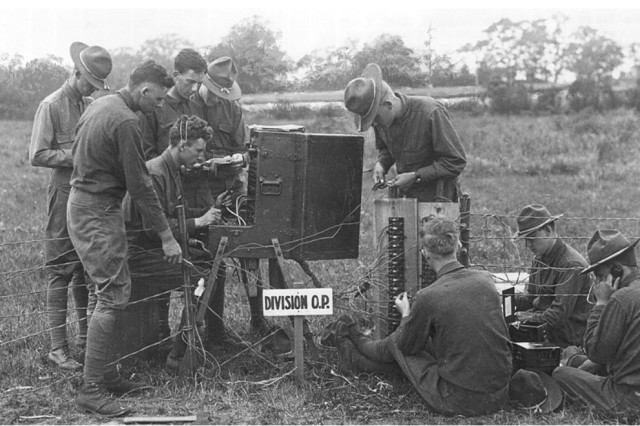ABERDEEN PROVING GROUND, Md. – In April 1973, a long-rumored move was officially announced – the U.S. Army Signal Center and School, which was established at what was then called Camp Little Silver (later Fort Monmouth) in 1919, was to move all activities from Fort Monmouth, New Jersey to Fort Gordon, Georgia. The move was initially to be completed by the end of June 1974, but the final class graduated from was then called the Fort Monmouth Army Communications Electronics School in June 1976, ending a run of more than 56 years at Fort Monmouth.
Although October 1, 1919, marks the formal establishment of the Signal School at Fort Monmouth, training in some courses dated back to 1917, when Camp Little Silver was first established. At that time the curriculum included physical training, dismounted drill, pitching tents, first aid, cryptography, heliograph, semaphore and wig-wag. At the time of the final graduation, training focused on educating soldiers to operate, repair, manage and engineer satellite and computerized systems for worldwide communications.
When requesting authorization for setting up the Signal School, Colonel F.R. Curtis, Acting Chief Signal Officer, wrote, “The War with Germany has demonstrated the fact that only technically competent officers should be assigned to the Signal Corps company duty, that junior officers of the Signal Corps should have a technical knowledge of telephone, telegraph, and radio activities.” The first Signal School class was made up of 225 students, and classes were conducted in four hangars, built in 1917 to house aircraft and equipment used in airplane direction-finding experiments. The common course work for officers throughout the 1920s included over 1,000 hours of instruction, while the enlisted courses were 9 months in length (offered course included Radio Electrician, Telephone Electrician, Telephone and Telegraph Electrician, and Meteorologist). The advent of World War II resulted in more extensive demand for communications specialists. An Officer Candidate Department was active in 1941, and 21,000 second lieutenants were graduated within the first three years. In addition, the Replacement Center had already trained 13,000 enlisted specialists by 1941, adding an additional 45,000 by war’s end. Upwards of 11,000 soldiers were trained in the first months of 1951 with the advent of hostilities in Korea.
In the 1960s, during the build-up for the Vietnam War, the school was utilizing 500 classrooms in 175 separate building. Classes were conducted in three-shifts over the course of the day, five days a week. In 1970, a peak year, 13,229 enlisted personnel and 1,788 officer passed through the school. A combined military and civilian staff and faculty number 2,500.
Recognized by educators as one of the world’s leading technical institutions, the Signal School pioneered many innovations in training and education, including systems of programmed learning. It was the first Army school to use television for instructions purposes. As early as 1951 it operated a closed-circuit TV system. During training for Vietnam, the school’s TV Division operated as many as 21 channels at once, 24 hours a day. The Signal School was also selected as the site for the implementation of the prototype of the computerized training system project. The system utilized a computer to present self-paced training material to a student over a visual devices, and guided them through practical exercises, called Computer Aided Instruction, or CAI. The school also researched and developed the Common Basic Electronics Training System (COBET), which provided a standardized functional entry-level training for use through the entire Training and Doctrine Command (TRACOM) service school system.
When the school finally closed its doors at Fort Monmouth, it could boast of having graduated some 280,000 servicemen and servicewomen of all ranks, and of all arms and services.




Social Sharing